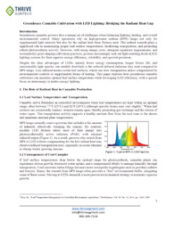How do our lights work?
The short answer: we use LEDs and custom phosphors to efficiently create photosynthetic light.
The long answer is a bit more complicated. Our technology is based on “Stokes Shift” or “Stokes fluorescence”. Here is how Wikipedia explains it:
Stokes fluorescence is the re-emission of longer wavelength photons (lower frequency or energy) by a molecule that has absorbed photons of shorter wavelengths (higher frequency or energy). Both absorption and radiation (emission) of energy are unique characteristics of a particular molecular structure. If a material has a direct bandgap in the range of visible light, the light shining on it is absorbed, causing electrons to become excited to a higher energy state. The electrons remain in the excited state for about 10^−8 seconds. This number varies over several orders of magnitude depending on the sample, and is known as the fluorescence lifetime of the sample. After losing a small amount of energy through vibrational relaxation, the molecule returns to the ground state and energy is emitted.

Every Thrive Agritech fixture starts with high bin royal blue LEDs. We call these “pump sources”. Blue LEDs have the short wavelengths needed to energize phosphors. Blue LEDs also happen to be extremely efficient. They create more light per watt than any other type of LED. We then shine the blue light onto phosphor(s). Our custom phosphors can emit various colors but generally we choose to create full-spectrum PAR light. The result is high performance.
Blue LEDs are are at least 35% more efficient than any other color and in many cases 3x or 4x more efficient. The light output of our lamps or fixtures can be any color but it is the blue LED that gives the performance advantage.
The future is looking bright. Blue LEDs are becoming more efficient and their cost is dropping every year. They even named a law after this called Haitz’s law. Similar to Moore’s law for computers, blue LEDs are rapidly improving year after year. This means that Thrive Agritech’s fixture are constantly becoming more efficient, brighter and lower cost.
